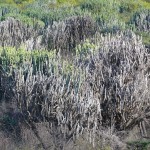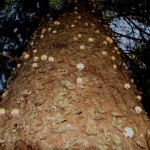Your Internet Gateway to Forest Information Resources – GFIS
The Global Forest Information Service (GFIS) provides the framework to share forest-related information through a single gateway at www.gfis.net. It promotes the dissemination and sharing of forest and tree-related information and knowledge among the global forestry community by developing common information exchange standards, building capacity and enhancing partnerships among forestry information providers and users. Read more…
Full-Service Forests: Food, Pharmaceuticals & Fibre
Translations of this story: Español , Français , Deutsch
Managing for wildlife habitat, soil stability, water, medicinal plants and foods – nuts, berries, and mushrooms – as well as timber resources, are now all part of most forest development plans and goals.
Today’s forest management looks toward sustaining a variety of resources as well as revenue from timber products. That’s at least partly because “a diversity of plant and animal species can improve the ability of a stand to survive under dramatic changes in environmental conditions including climate change,” says Dr. Valerie LeMay, Professor of Forest Biometrics and Measurements at Canada’s University of British Columbia.
It’s a change from the past when forests were managed primarily for timber resources. Today’s forest managers realize that even the structure of a stand – the variation in tree heights, diameters, location and species and the number of dead trees standing or lying in it – is an important aspect of managing for multiple benefits, she said.
Large gaps in a tree stand, for instance, provide light for new tree growth, but also for grasses, herbs, shrubs and other vegetation that often provide food for deer and other wildlife.
The question though, is how best to manage all this? Dr. LeMay and Dr. Peter Newton, Research Scientist at Natural Resources Canada, will coordinate a session that deals with managing and measuring stand structure for a diverse array of forest products at the 2010 IUFRO World Congress in Seoul.
- Photo taken by Felipe Crecente-Campo
- Measuring coarse woody debris and other structural elements below the tree canopy. Photo taken by UBC Forest Biometrics Research Lab
- Photo taken by Valerie Lemay
Interview with Jeremy Rayner on International Forest Regime
A short interview was done with the Chair of the Expert Panel on the International Forest Regime, Professor Jeremy Rayner, on the occasion of the first Expert Panel meeting in December 2009 in Vienna.
Climate Change Adds to Forest Threat
Only healthy forests can provide many important services upon which we rely – air quality and water cycle regulation; biodiversity and soil protection; carbon sequestration and mitigation of climate change, and social and cultural value.
Forest health has long been threatened by insect pests and diseases accidentally moved to new areas. More recently, climate change has become one of the greatest threats to forest and tree health, says Elena Paoletti, senior scientist at the Institute for Plant Protection of the National Council of Research of Italy. She adds “Climate change and air pollution pose new threats to forests and change their ability to tolerate stressors.”
Historically, climatic extremes, air pollution, insects and disease have been the main factors adversely affecting forest health. Understanding how these stress agents are affected by, and respond to climatic change is fundamental to our efforts to mitigate the impacts of a changing environment. Adaptive forest strategies must be developed.
She notes that, among other issues, climate change is resulting in the expansion of distribution ranges of some insect pests and pathogens. These range shifts have the potential to be permanent and to have significant implications on the future health of the world’s forests.
Dr. Paoletti will coordinate a sub-plenary session at the 2010 IUFRO World Congress in Seoul. The aim will be to update forest scientists and managers regarding new breakthroughs in the field of forest tree health and especially to better understand the multi-faceted aspects of climate change.
Read this story in Spanish, French or German






